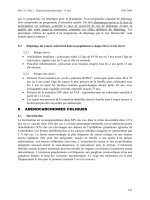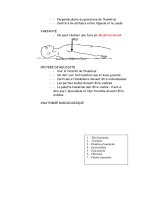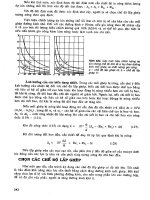Charting Made Easy Part 5 potx
Bạn đang xem bản rút gọn của tài liệu. Xem và tải ngay bản đầy đủ của tài liệu tại đây (414.59 KB, 23 trang )
OSCILLATORS
O
scillators are used to identify overbought and over-
sold market conditions. The oscillator is plotted on
the bottom of the price chart and fluctuates within a
horizontal band. When the oscillator line reaches the upper
limit of the band, a market is said to be overbought and vulner-
able to a short-term setback.When the line is at the bottom of
the range, the market is oversold and probably due for a rally.
The oscillator helps to measure market extremes and tells the
chartist when a market advance or decline has become over-
extended.
Relative Strength Index (RSI)
This is one of the most popular oscillators used by technical
traders.The RSI scale is plotted from 0 to 100 with horizontal
lines drawn at the 70 and 30 levels.An RSI reading above 70 is
considered to be overbought.An RSI reading below 30 is con-
sidered to be oversold.The most popular time periods for the
RSI are 9 and 14 days (See Figure 13-1).
Stochastics
This oscillator is also plotted on a scale from 0 to 100.
However, the upper and lower lines (marking the overbought
Chapter 13
Charting Made Easy 47
and oversold levels) are at the 80 and 20 levels. In other words,
readings above 80 are overbought,while readings below 20 are
oversold. One added feature of stochastics is that there are two
oscillator lines instead of one. (The slower line is usually a 3-day
moving average of the faster line). Trading signals are given
when the two lines cross.A buy signal is given when the faster
line crosses above the slower line from below 20.A sell signal is
given when the faster line crosses beneath the slower line from
above 80.The time period used by most chart analysts is four-
teen days (See Figure 13-2).
Any Time Dimension
As is the case with most technical indicators, these oscillators
can be employed in any time dimension.That means they can
be used on weekly, daily, and intraday charts. It’s a good idea to
use the same time span in all time dimensions.When plotting
48 Trade Secrets
A 9-day RSI oscillator applied to the Dow Industries. RSI readings over 70 often coin-
cide with short-term pullbacks. Readings below 30 often identify market bottoms.
Figure 13-1. RSI OSCILLATOR Dow Jones Industrial Average
Daily Closes
9-Day Relative Strength Index (RSI)
Overbought
Oversold
Charts powered by MetaStock
Charting Made Easy 49
The 14-day stochastics oscillator applied to the S&P 500. The last two bottoms in the
S&P were marked by oversold stochastic readings below 20. Readings over 80 coin-
cided with several short-term peaks.
Figure 13-2. STOCHASTICS OSCILLATOR S&P 500 Index
Daily Bars
Overbought
Oversold
14-Day Stochastics
the stochastics lines, for example, use 14 weeks on the weekly
chart, 14 days on the daily chart, and 14 hours on an hourly
chart, etc.Another reason for keeping the same numbers is that
computers allow you to switch back and forth between week-
ly, daily, and intraday charts with a keystroke. Using the same
time spans in all time dimensions makes your work a lot easier.
Charts powered by MetaStock
RATIOS AND RELATIVE STRENGTH
T
echnical analysis can be applied to ratio charts. Trend-
lines and moving averages, for example, can help mea-
sure trends on ratios and can alert the user to changes
in those trends.A close monitoring of the ratio charts can add a
valuable dimension to market analysis.
Sector Ratios
Chapter 11 recommended using a “top-down” market ap-
proach to find winning sectors, industry groups, and individual
stocks. That is done by applying ratio analysis to determine
each market’s relative strength. When choosing industry
groups, for example, the common technique is to divide an
industry index (like the Semiconductor Index) by a market
benchmark like the S&P 500.When the ratio line is rising, that
means the industry is outperforming the general market.When
the ratio is falling, that industry is lagging behind the rest of the
market. The idea is to concentrate your attention on groups
with rising ratios and avoid those groups with falling ratios.That
way you’ll be buying only those industry groups that are show-
ing superior relative strength.
Stock Ratios
Once you’ve identified a winning group, you can apply ratio
analysis to the stocks in that group. Simply divide the individ-
Chapter 14
Charting Made Easy 51
52 Trade Secrets
ual stocks in the group by the group index itself. The stocks
with rising ratio lines are the strongest stocks in the group.The
idea here is to find the stocks in the group that are showing the
greatest relative strength. That way you’ll be buying the
strongest stocks in the strongest groups.
Market Ratios
Ratio analysis can also be used to compare major market aver-
ages. By dividing the Nasdaq Composite Index by the S&P 500,
for example,you can determine if technology stocks are leading
or lagging the rest of the market.You can use the Russell 2000
versus the S&P to gauge the relative strength (or weakness) of
smaller stocks (See Figure 14-1).
The rising Nasdaq/S&P 500 ratio shows remarkable relative strength in the technology
sector during the last quarter of 1999 and the first quarter of 2000. The breaking of the
up trendlines, however, signalled new relative weakness in technology. Ratio charts
are a good way to spot sector rotations within the stock market.
Figure 14-1. RATIOS AND RELATIVE STRENGTH Nasdaq/S&P 500 Ratio
Charts powered by MetaStock
OPTIONS
O
ptions give the holder the right, but not the obliga-
tion, to purchase (in the case of a call) or sell (in the
case of a put) an underlying market entity at a specif-
ic price within a specified period of time. In its simplest appli-
cation, a trader who is bullish on a market can simply purchase
a call; a trader who is bearish can simply purchase a put.
The main advantage in options trading is limited risk. The op-
tion trader pays a premium to purchase the option. If the market
doesn’t move as expected, the option simply expires.The maxi-
mum loss the option trader can suffer is the size of the premium.
There are countless option strategies that can be utilized by
option traders. However, most option strategies require a mar-
ket view. In other words, the option trader must first determine
whether the market price of the underlying market contract is
going to rise, fall, or stay relatively flat.This is because the major
factor influencing the value of an option is the performance of
its underlying market. In determining an appropriate option
strategy, it’s important to remember that the principles of mar-
ket analysis are not applied to the option itself, but to the
underlying market.
Therefore, it can be seen that the principles of chart analysis
covered in the preceding pages and their application to the
financial markets play an important role in options trading.
Chapter 15
Charting Made Easy 53
54 Trade Secrets
Option Put/Call Ratio
Trading activity in the options markets is used to generate a
popular stock market sentiment indicator — called the put/call
ratio. This ratio is actually a ratio of put volume divided by call
volume. It is generally applied to the S&P 100 (OEX) index op-
tion traded on the Chicago Board Options Exchange (CBOE) or
the CBOE Equity put/call ratio, which uses option volume in
individual stocks.
Contrary Indicator
The S&P 100 or the CBOE Equity put/call ratio is a contrary
indicator. In other words, a high put/call ratio is considered
bullish for the market (because it shows too much bearish sen-
timent). In the same way, a low put/call ratio (which betrays
strong bullish sentiment) is considered bearish for the market.
The reasoning behind the put/call ratio being used as a contrary
indicator is based on the idea that option traders get too bullish
near market tops and too bearish near market bottoms.
CBOE Volatility Index (VIX)
This contrary indicator is based on the volatility of the S&P
100 (OEX) index option. Since it is a contrary indicator,a rising
VIX index implies greater volatility and growing concern about
downside movement in the stock market. By contrast, a falling
VIX implies less volatility and more confidence in the market.
The VIX usually trades in a band between 30 and 20.Dips below
20 are usually associated with market peaks. Moves above 30
are usually associated with market bottoms.
THE PRINCIPLE OF
CONFIRMATION
T
he principle of confirmation holds that the more tech-
nical evidence supporting a given analysis, the stronger
the conclusion becomes. In the study of an individual
market, for example, all of the technical signs should be point-
ing in the same direction. If some signs are pointing up and the
others down, be suspicious. Consult other stocks in the same
group.A bullish analysis in a stock would be less than convinc-
ing if the other stocks in its group were trending lower. Since
stocks in the same group tend to move together, make sure that
the other stocks agree with the one being studied.
Look at the various technical indicators to see if they agree.Are
the chart patterns being confirmed by the volume? Do the mov-
ing averages and oscillators confirm the chart analysis? What do
the weekly and monthly charts show? While it is seldom that all
of these technical factors will point in the same direction,it pays
to have as many of them in your corner as possible.
Chapter 16
Charting Made Easy 55
SUMMARY AND CONCLUSION
W
e have provided here an introduction to technical
analysis as it is applied to the financial markets.
We’ve discussed briefly the major tools utilized by
the chartist, including: basic chart analysis, the study of volume,
moving averages, oscillators, ratios, weekly, and intraday charts.
The successful trader learns how to combine all these elements
into one coherent theory of market analysis.
The many software and Internet-based products available on
the market today also provide powerful tools that make chart-
ing and technical analysis much easier — and far more accessi-
ble to general investors — than ever bef ore. For example, many
software and Internet-based products include a full suite of
technical analysis tools that allow you to create charts easily,
have instant access to historical data,and have the ability to cre-
ate, backtest and optimize self-designed trading systems with-
out any programming knowledge or experience.
▲ ▲ ▲ ▲ ▲ ▲
Technical analysis provides an excellent vehicle for market
forecasting, either with or without fundamental input. Where
technical analysis becomes absolutely essential, however, is in
Chapter 17
Charting Made Easy 57
58 Trade Secrets
the area of market timing. Market timing is purely technical in
nature, so successful participation in the markets dictates some
application of technical analysis.
It’s not necessary to be an expert chartist to benefit from
chart analysis. However, chart analysis will go a long way in
keeping the trader on the right side of the market and in help-
ing to pinpoint market entry and exit points, which are so vital
to trading success.Whether the participant is a day trader or a
long-term investor, it’s to his or her advantage to learn about
chart analysis.
Investing
Resource
Guide
▲ ▲ ▲ ▲ ▲ ▲
TOOLS FOR SUCCESS
IN INVESTING
Charting Made Easy 61
Technical Analysis of the Financial Markets
by John Murphy
From how to read charts to understanding indicators and the
crucial role of technical analysis in investing, you will not find a
more thorough or up-to-date source.This comprehensive guide,
revised and expanded for today’s changing financial world, ap-
plies to both equities and futures markets. A must have refer-
ence, from the industry expert.
$80.00 Item #BC94-10239
Martin Pring’s Introduction to Technical Analysis
A CD-Rom Seminar and Workbook
by Martin J. Pring
The foremost expert on technical analysis and forecasting finan-
cial markets gives you a one-on-one course in every aspect of
technical analysis.This interactive guide explains how to evaluate
trends, highs & lows, price/volume relationships, price patterns,
moving averages, and momentum indicators.
The accompanying CD-ROM includes videos, animated diagrams
audio clips and interactive tests. It’s the user-friendly way to mas-
ter technical analysis from an industry icon.
$49.95 Item #BC94-8521
▲ ▲ ▲ ▲ ▲ ▲
To order any book listed
Call 1-800-272-2855 ext. BC94
SUGGESTED READING
62 Trade Secrets
Technical Analysis Simplified
by Clif Droke
Here’s a concise, easy-reading manual for learning and imple-
menting this invaluable investment tool.The author, a well-known
technician and editor of several technical analysis newsletters, dis-
tills the most essential elements of technical analysis into a brief,
easy-to-read volume.
$29.95 Item #BC94-11087
How Charts Can Help You in the Stock Market
by William L. Jiler
William Jiler's book is the must-have primer on technical
analysis. First published in 1962, it was the first book to
explain how all investors can use charting to more profitably
time both their buys and sells. It is globally renowned to this
day for helping traders and investors use the tools of techni-
cal analysis to increase their profits.
Featuring a new Foreword by the investing experts at
Standard & Poor's, this special reprint edition will be an excel-
lent resource for beginners as well as a vital reference for
experienced technicians.
$19.95 Item #BC94-1661720
▲ ▲ ▲ ▲ ▲ ▲
To order any book listed
Call 1-800-272-2855 ext. BC94
Charting Made Easy 63
The MetaStock Difference
Make sure you’re getting the most advanced
technical analysis software available—
choose MetaStock
®
.
Greater Depth. Study your charts with nine
charting styles. Calculate moving averages
with seven different methods. Plus, choose
from over 120 indicators and line studies.
Create, Backtest, Optimize, and
Compare Your Trading Systems.
Scan your databases to find the winners.
Learn from noted experts to spot important
trading situations, and more. You’ll never
outgrow MetaStock.
Easy to Use. You only need to learn two
commands to run MetaStock: Click & Pick
and Drag & Drop. Moving price plots, etc.
is extremely easy. And making changes to
objects is even easier.
You’ll Love MetaStock! MetaStock does
it all. From finding what to trade, to knowing
when to trade, MetaStock is available on a
monthly subscription or a one-time purchase
plan.
Free Data CD. Order MetaStock now
and get a free data CD with over 5 years
of historical data, covering over 30,000
securities.
CCaallll ffoorr aa ffrreeee iinnffoorrmmaattiioonn
ppaacckk
11 880000 227722 22885555
EExxtt BBCC9944
A Product
MetaStock is a registered trademark of Equis International, Inc. All other product names are property of their respective owners.
©2000, Equis International, Inc.
64 Trade Secrets
Get strong buy and sell signals with . . .
John Murphy’s
CPR
John Murphy’s Chart Pattern Recognition
™
(CPR), plug in software
for MetaStock 7.0, can help you make better buy and sell decisions in just
three easy steps!
Step 1: Find charts with good pattern trading potential. Quickly scan
thousands of charts using MetaStock 7.0 from Equis and CPR.You’ll find
charts with definite patterns and even in the early stages of patterns.
Step 2: Focus on specific chart patterns.
With a list of the best candidates, you can now
analyze individual charts with CPR and MetaStock
7.0’s Expert Advisor
™
. CPR will label both
Reversal Patterns and Continuation Patterns.
Step 3:
Receive insightful, detailed commentary. Know exactly how
to place your buy and sell positions, and even where to place your stops. This
commentary also projects where the security price may move within a specified
period of time.Also generate trading alerts with patterns. Each pattern is
computer verified and supplemented with John’s own expert commentary.
There is no other product on the market that implements the experience and
expertise of John Murphy with the computerized technology of MetaStock.
The result is simple: you’ll make better trading decisions.
Call Today for your copy of CPR and MetaStock.
1-800-272-2855
Extention BC94
Reversal Patterns: Head and Shoulders, Inverse Head and Shoulders,
Double Tops,Triple Tops, Double Bottoms, and Triple Bottoms.
Contin
uation Patterns: Symmetrical,Ascending, and Descending Triangles.
This product is not a recommendation to buy or sell, but rather a guideline to interpreting the specified analysis methods. This information should only be used
by investors who are aware of the risk inherent tin securities trading. Equis International, MurphyMorris, John Murphy, and Greg Morris accept no liability what-
soever for any loss arising from any use of this product or its contents. ©2000 Equis International, Inc. MetaStock is a registered trademark of Equis
International.
John Murphy Products
Technical Analysis Tools from the World’s Foremost Market Technician
Mastering High Probability Chart
Reading Methods with John Murphy
82 min. video $99.00 Item# BC94-2044547
Renowned technical analyst John Murphy shows you step-
by-step how to pinpoint the right sectors to play at the
right time - with profits in tow. Citing key relationships
among markets, Murphy's methods help you determine
when to move from one to the other, so you're poised to
capture the most lucrative opportunities available in any
market climate. With a full online support manual avail-
able at www.traderslibrary.com/tradesecrets, Murphy's on-tar-
get cues for rotating among sectors will keep you in the "hot" winning ones, at the best
points in the business cycle - time after time.
Intermarket Analysis: Profits From Global
Market Relationships
John Murphy $69.95 Item#BC94-1523697
Drawing on his vast experience as both an educator and
an expert trader, the author lays out his key tools to
understanding global markets and illustrates how these
tools can help today's serious investors profit in any eco-
nomic climate. Murphy incorporates and reflects on the
most recent world market data to show how seemingly
disparate world markets interact and ultimately influ-
ence each other. The book includes practical applica-
tions of Murphy's popular analysis technique. Armed
with the knowledge of how economic forces impact the
various markets and sectors, investors and traders can
profit by exploiting opportunities in markets about to
rise and avoiding those poised for a fall.
Charting Made Easy 65
Order NOW: 800-272-2855 ext. BC94
Online orders: www.traderslibrary.com/ BC94
@
Save Now with
Rewards Weekly
This exclusive e-mail service gives
you, our preferred customer, a
different special offer - every week!
Take advantage of:
• FREE books, videos & software offers
• Deeply DISCOUNTED titles
• FREE SHIPPING offers
• And information on new books
Investment conferences
and much, much, MORE!
Don’t miss out!
Go to:
www.traderslibr ary.com/BC94
and start saving today
with Rewards Weekly!
Charting Made Easy 67
About the Author
▲ ▲ ▲ ▲ ▲ ▲
John Murphy has authored three best-selling books on
technical analysis, including Intermarket Technical
Analysis and The Visual Investor. His latest work,
Technical Analysis of the Financial Markets (1999),is
a revised edition of his 1986 classic text which has
been translated into eight languages.He is president of
MURPHYMORRIS.COM which produces interactive
educational products on technical analysis and online
analysis for investors. As the former host of CNBC’s
Tech Talk show and a speaker at all the major trading
and investment forums and conferences around the
world, Mr. Murphy is one of the most recognized and
highly respected technical analysts of our time.
This book, along
with other books,
are available at discounts
that make it realistic to provide them as
gifts to your customers, clients, and staff.
For more information on these long last-
ing, cost effective premiums, please call
John Boyer at 800-272-2855 or e-mail
him at









